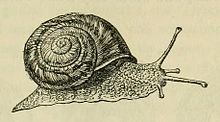Coming Alive at a Snail’s Pace

In 1846, a lawyer/explorer named Charles Lamb took a trip to Egypt, Greece, and other areas around the Mediterranean. Lamb collected some snails along the way (a weird hobby, for sure) and sent them off to the British Museum in an effort to add to the Museum’s collection of mollusks (a weird collection, to match). Unfortunately, one of the specimens — a desert-dweller known as Helix desertorum at the time, now Eremina desertorum — died in transit.
Ultimately, that didn’t matter much. The museum didn’t have a live snail from the Arabian desert, and let’s face it — as snails don’t do much, a dead snail makes for a good exhibit, too. So the museum glued it down to a piece of cardboard and put it on display. And there it stayed, like any good, dead snail would, for the next four years.
But in 1850, something happened which shouldn’t have. As one essayist recounted, the cardboard, near where the snail was glued, became discolored, as if the snail has secreted something. The museum’s curator, William Baird, suspected that, despite all odds, the snail was somehow alive. So he decided to confirm his suspicion. Per Mental Floss, “Baird unstuck the shell from its cardboard tablet and placed it in a basin of tepid water. After a few moments, a head popped out of the shell, and the snail, quite alive, began to move around.” Despite being denied any sort of sustenance or the ability to move for four years, the dead snail was, miraculously, not dead.
You can forgive the museum — land snails “move at a proverbially low speed,” as Wikipedia so eloquently summarizes. Some species only move about a millimeter per second — at that rate, it’d take more than a day for a snail to cross a football field from goal line to goal line. Unless you’re really paying attention, you could mistake a very-much-alive one for a no-longer-living one. And in this snail’s case, the fact that it was a desert species meant it was able to go for very long periods (years, apparently) without food or water.
Of course, not even this snail could go hungry forever, and rather than test things further, the museum began feeding it. It also placed the not-quite-dead snail it in a jar with another snail, giving it as close to a reasonable habitat as a museum in England of the 1850s could. The desert snail lived for another two years afterward, and, for the second time (but for the first time correctly), was declared dead in 1852. Its shell — and the drawing above — are now on display instead.
Bonus fact: Snails travel slowly, but snail populations can appear at distances far away from one another. So, how do snail populations spread? Most likely, they fly. No, snails don’t have wings, but they can catch a ride with birds — in a gross way. The birds eat the snails but, as the BBC explains, that’s not necessarily a death sentence for the tiny animals: “researchers found that 15% of the snails eaten survived digestion and were found alive in the birds’ droppings. ”
From the Archives: Die Hard: The would-be murder victim who wouldn’t die.
